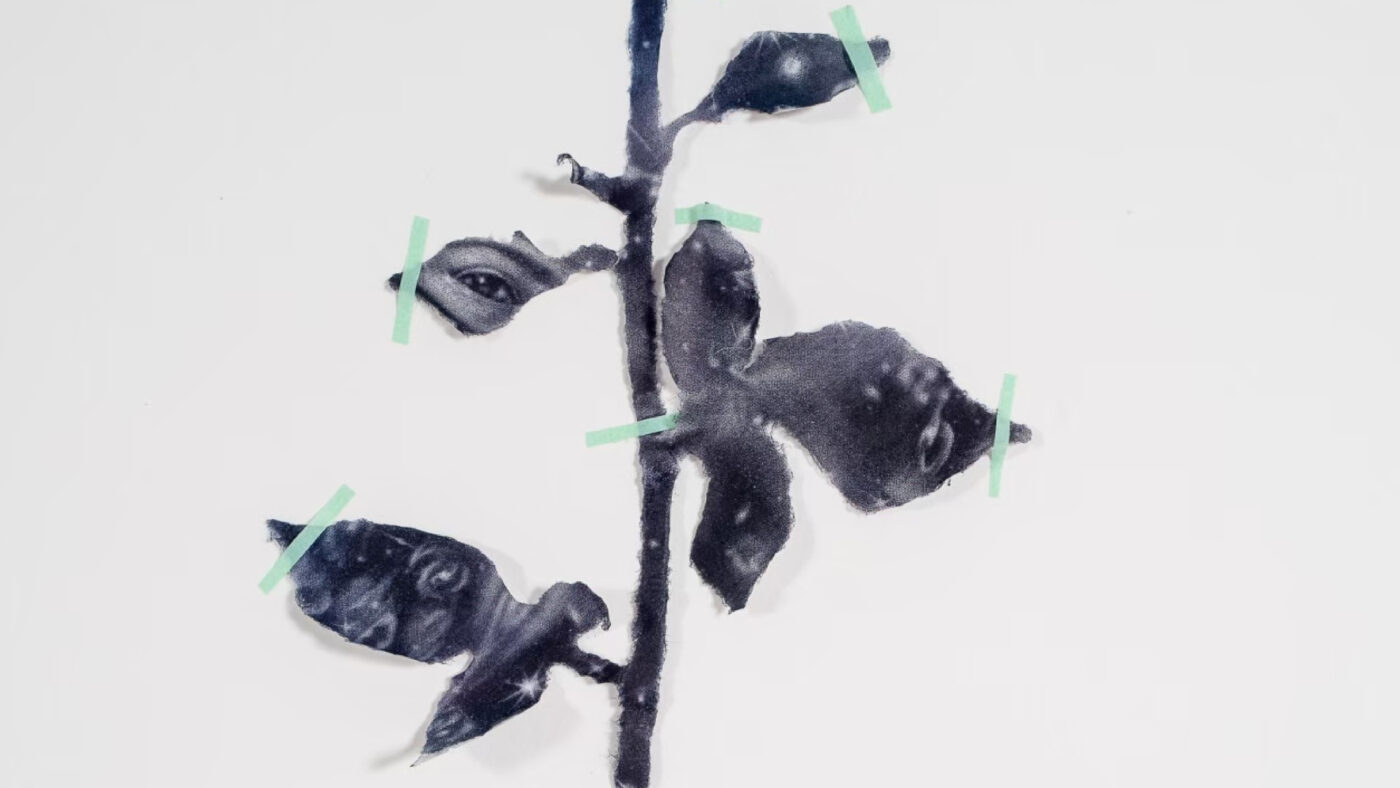前往美術館看展,如果閉館時間快到了,但你發現還剩好多作品沒看,這種時候很容易會在「快速把所有作品都瀏覽一遍」以及「專注與某幾個有緣的作品交流」之間搖擺不定。這其實是價值觀的問題——你想要廣納還是要深掘?許多人會選擇前者,原因是都特地來看展了不把所有作品看過一遍好像很浪費,尤其是短期內不太可能再去一次的地點,雖無暇細細琢磨,至少都有看到。
研究顯示觀展民眾在每一件作品前面停留的平均時間是8秒鐘,在這8秒之間,你閱讀畫面、試著理解、判斷這件作品在你心中的價值、決定離開的時機。有些作品的意義需要透過觀眾主動閱讀背景資料才能夠浮現,有些作品則無法以言語說明,只能藉由感受來體會;無論哪種作品,如果是視覺藝術,那至少可以先停下腳步盯著看。超過8秒之後或許你會發現原來作品中有第一眼沒看見的東西存在,再繼續看,就會發現更多。

楊忠銘 〈無華之境系列: B612 fig. 3〉(局部) 2024 銅版美柔汀、浮水印手抄紙、中國裱貼法
YANG Chung-Ming, Flora of Formosa: B612 fig. 3 (Detail), 2024, Mezzotint, Watermark, Handmade Paper, Chine-collé
於是近年來英國Tate美術館與美國MoMA現代藝術博物館等大型美術館都推出了「Slow Looking」慢速觀展指南,引導觀眾選擇任何一件令自己有點好奇的作品,並花個10分鐘左右與作品相處。Tate更列出了下列的小撇步,希望讓觀眾在輕鬆的觀展體驗中獲得發自內心的感受:
Make yourself comfortable. Find a place, bench, stool or space on the floor that gives you a good view of the work. Feel free to stand or move around the artwork, to explore different perspectives.
首先找個地方,讓自己可以用放鬆的姿勢看著作品。可以坐在長椅、板凳或地上,站著或是一邊稍微移動一邊觀察作品不同角度也很棒。
Don’t worry if nothing comes to mind at first. Be patient. Try focusing your attention on a particular detail. Try to forget any expectations, as well as anything you ‘know’ about the artwork. Keep an open mind. If you are still struggling, consider one of the following themes as an entry point: texture, colour, shape, symbols, story, perspective.
即使看不出個所以然也別擔心。先把腦袋放空,不需要想著「看懂」,可以試著將注意力放在畫面的某個細節上,像是表面的質感、顏色、形狀、符號、故事(如果有的話)、角度或是透視等。
Trust in your own authority and intuition. Pay attention to your first impressions. Don’t underestimate the reason why you were drawn to the work in the first place.
相信你的直覺。不要小看第一印象,你會想要繼續留在這件作品前面一定有其原因。
Let your eyes wander. Your mind will try and make connections between elements of the work. These connections might be intended by the artist, or unique to you. It doesn’t matter, both are valid. See things from a fresh perspective. Make the familiar strange. Try and spot the details hiding in plain view.
讓目光自由自在的移動。你的大腦會自動把你看到的元素組織起來,歸納出它們之間的關聯性,這有可能是藝術家的安排,也有可能是你自己的解讀,無論如何這都是有價值的。帶著嶄新的眼光,試著用不一樣的角度來思考常見的景象吧,說不定能看見隱藏在平淡無奇之中的絕妙細節!
Be aware of your surroundings. Don’t try too hard to shut out what is going on around you. Don’t be put off by those squeaky shoes or the sound of visitors chatting, this is part of the fun of slow looking.
覺察周遭環境。不需要維持過於高度的專注,或刻意隔絕周遭的聲響干擾,這也是慢速觀展的樂趣之一。
How do you feel? Pay attention to how your mind and body respond. This might be in a subtle way. Does the art help you feel calm, does it irritate you, excite you? Does it trigger any memories?
回望內心。看展過程中,你的身心有何感受或回應呢?或許不一定很強烈,但是這些藝術作品有讓你覺得平靜、煩躁、興奮,或者引起你心中任何回憶嗎?
Share your findings. How do you feel about this artwork now you have studied it in detail? Try and summarise your thoughts. This could be in your head, with your friends, or with the strangers looking at the artwork with you.
把你發現的事情化為言語。你對這個已經相處了一下子的藝術作品有什麼樣的感覺呢?試著在腦中整理自己的想法,或者說給朋友聽,甚至跟旁邊一起看作品的陌生人分享也很好。
Look again. Try a different artwork, the same artwork, straight away, after a coffee break, on a different day. How does it look in other conditions: on a rainy day, on a bad hair day, on your birthday?
最後,可以的話請再試一次。另外選一件作品、或是直接重看原本的作品、過一下子、或是過好幾天,都沒問題。在一個不同的狀況下(譬如下大雨、頭髮剪壞、或是你的生日等等),作品給你的感覺是一樣的嗎?
當然,慢速觀展意味著只能挑幾件最打中你的作品,好好進行對話。假設你在每件作品前都花15分鐘,以Tate美術館的館藏78,000件作品來計算,你會需要每天泡在美術館裡12小時,至少四年以上的時間才有可能看完。因此與其把美術館的展品當成是待辦清單,或許想成一份供你選擇的菜單會更加適切。畢竟作品其實跟人一樣,需要花時間相處才能真正認識對方,你會有知心好友,也會有點頭之交;然後你們一起經歷過的事情,還有你對他們的看法,都是屬於你的獨一無二的東西。同理,不管策展人、藝術史學者甚至藝術家本人怎麼說,你自己對作品的感覺永遠是最有意義的。
本文部分內容編譯自 Tate Gallery: A guide to slow looking
曜畫廊 Gallery de sol
座落於頂級經典的文華東方酒店內,定位在強調藝術史研究的學術性藝廊,致力於推廣版創藝術作品。



 English
English